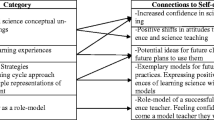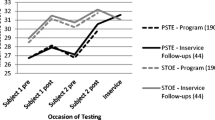Abstract
The purpose of this mixed methods research was to investigate the development of 55 preservice elementary teachers’ science teaching self-efficacy beliefs through analysis of their reflective practices in a science method course. This year-long study was conducted at two public universities located in the USA and Canada. Within the theoretical frameworks of science teaching self-efficacy and reflective practice, we examined how and in what ways preservice teachers’ reflections on their past science experiences and current science teaching practices contributed to their self-efficacy beliefs. Data were collected from pre- and post-course administrations of the Science Teaching Efficacy Belief Instrument-B (STEBI-B), written science autobiographies, written reflection papers, classroom observations, and artifacts. A repeated-measures analysis of variance (ANOVA) was used to test the significance of the differences between the pre- and post-course survey scores. The results indicated statistically significant gains in participants’ science teaching self-efficacy beliefs. The qualitative analysis revealed that preservice teachers’ initial self-efficacy beliefs evolved through years of formal and informal interactions with science. New levels of self-efficacy were reached, as evident from participants’ self-reflection on their field teaching. The findings indicate the importance of field experiences and reflective practices for preservice elementary teachers’ preparation and science teaching self-efficacy. The study offers implications for preservice teacher education programs, science teacher education, and research.
Similar content being viewed by others
References
Abell, S. K. (2007). Research on science teacher knowledge. In S. K. Abell & N. G. Lederman (Eds.), Handbook of research on science education (pp. 1105–1149). Mahwah, NJ: Lawrence Erlbaum Associates.
Aldridge, J. M., & Fraser, B. J. (2016). Teachers’ views of their school climate and its relationship with teacher self-efficacy and job satisfaction. Learning Environments Research, 19(2), 291–307.
Amobi, F. A. (2005). Preservice teachers' reflectivity on the sequence and consequences of teaching actions in a microteaching experience. Teacher Education Quarterly, 32(1), 115–130.
Appleton, K. (1995). Student teachers’ confidence to teach science: Is more science knowledge necessary to improve self-confidence? International Journal of Science Education, 17(3), 357–369.
Ashton, P. T., & Webb, R. (1982). Teachers’ sense of efficacy: Toward an ecological model. Paper presented at the annual meeting of the American Educational Research Association, New York, NY.
Australian Curriculum, Assessment and Reporting Authority [ACARA]. (2015). Australian Curriculum. Retrieved from http://www.australiancurriculum.edu.au. Accessed 15 June 2019.
Avery, L. M., & Meyer, D. Z. (2012). Teaching science as science is practiced: Opportunities and limits for enhancing preservice elementary teachers’ self-efficacy for science and science teaching. School Science and Mathematics, 112(7), 395–409.
Avraamidou, L. (2019). Stories we live, identities we build: How are elementary teachers’ science identities shaped by their lived experiences? Cultural Studies of Science Education, 14(1), 33–59.
Bandura, A. (1977). Social learning theory. Englewood Cliffs, NJ: Prentice Hall.
Bandura, A. (1982). Self-efficacy mechanism in human agency. American Psychologist, 37(2), 122–147.
Bandura, A. (1986). Social foundations of thought and action: A social cognitive theory. Englewood Cliffs, NJ: Prentice Hall.
Banilower, E. R., Smith, P. S., Weiss, I. R., Malzahn, K. A., Campbell, K. M., & Weis, A. M. (2013). Report of the 2012 National Survey of science and mathematics education. Chapel Hill, NC: Horizon Research, Inc..
Bautista, N. U. (2011). Investigating the use of vicarious and mastery experiences in influencing early childhood education majors’ self-efficacy beliefs. Journal of Science Teacher Education, 22(4), 333–349.
Bleicher, R. E. (2004). Revisiting the STEBI-B: Measuring self-efficacy in preservice elementary teachers. School Science and Mathematics, 104(8), 383–391.
Brand, B. R., & Wilkins, J. L. (2007). Using self-efficacy as a construct for evaluating science and mathematics methods courses. Journal of Science Teacher Education, 18(2), 297–317.
Cantrell, P. (2003). Traditional vs. retrospective pretests for measuring science teaching efficacy beliefs in preservice teachers. School Science and Mathematics, 103(4), 177–185.
Chandrasegaran, A. L., Treagust, D. F., & Mocerino, M. (2007). The development of a two-tier multiple choice diagnostic instrument for evaluating secondary school students’ ability to describe and explain chemical reactions using multiple levels of representation. Chemical Education Research and Practice, 8(3), 293–307.
Cook, T. D. (1985). Postpositivist critical multiplism. In L. Shotland & M. M. Mark (Eds.), Social science and social policy (pp. 21–62). Beverly Hills, CA: Sage.
Creswell, J., & Plano Clark, V. (2007). Designing and conducting mixed methods research. Thousand Oaks, CA: Sage.
Darling-Hammond, L. (2000). Solving the dilemmas of teacher supply, demand, and standards: How can we ensure a competent, caring, and qualified teachers for every child. New York, NY: National Commission on teaching and America’s Future.
Davis, E. A. (2006). Characterizing productive reflection among preservice elementary teachers: Seeing what matters. Teaching and Teacher Education, 22, 281–301.
Denscombe, M. (2008). Communities of practice. Journal of Mixed Methods Research, 2, 270–283.
Dewey, J. (1933). How we think: A restatement of the relation of reflective thinking to the educative process. Boston, MA: Houghton Mifflin.
Enochs, L. G., & Riggs, I. M. (1990). Further development of an elementary science teaching belief instrument: A preservice elementary scale. School Science and Mathematics, 90, 694–706.
Gibson, S., & Dembo, M. H. (1984). Teacher efficacy: A construct validation. Journal of Educational Psychology, 76(4), 569–582.
Greene, J. C. (2007). Mixed methods in social inquiry. San Francisco, CA: Jossey-Bass.
Gunning, A. M., & Mensah, F. M. (2011). Preservice elementary teachers’ development of self-efficacy and confidence to teach science: A case study. Journal of Science Teacher Education, 22(2), 171–185.
Guskey, T. R., & Passaro, P. D. (1994). Teacher efficacy: A study of construct dimensions. American Educational Research Journal, 31(3), 627–643.
Hallgren, K. (2012). Computing inter-rater reliability for observational data: An overview and tutorial. Tutorials in Quantitative Methods for Psychology, 8, 23–34.
Hancock, E. S., & Gallard, A. J. (2004). Preservice science teachers’ beliefs about teaching and learning: The influence of K-12 field experiences. Journal of Science Teacher Education, 15(4), 281–291.
Hatton, N., & Smith, D. (1995). Reflection in teacher education: Towards definition and implementation. Teaching and Teacher Education, 11(1), 33–49.
Hawkins, S., & Park Rogers, M. (2016). Tools for reflection: Video-based reflection within a preservice community of practice. Journal of Science Teacher Education, 27(4), 415–437.
Hechter, R. P. (2011). Changes in preservice elementary teacher’s personal science teaching efficacy and science teaching outcome expectancies: The influence of context. Journal of Science Teacher Education, 22(2), 187–202.
Jay, J., & Johnson, K. (2002). Capturing complexity: A typology of reflective practice for teacher education. Teaching and Teacher Education, 18, 73–85.
Jensen, L., Huber, C., Cundick, B., & Carlson, J. (1991). Development of a self-theory and measurement scale. Journal of Personality Assessment, 57(3), 521–530.
Kier, & Lee. (2017). Exploring the role of identity in elementary preservice teachers who plan to specialize in science teaching. Teaching and Teacher Education, 6, 199–210.
Kleinknecht, M., & Schneider, J. (2013). What do teachers think and feel when analyzing videos of themselves and other teachers teaching? Teaching and Teacher Education, 33, 13–23.
Knaggs, C., & Sondergeld, T. (2015). Science as a learner and as a teacher: Measuring science self-efficacy of elementary preservice teachers. School Science and Mathematics, 115(3), 117–128.
Lee, H. J. (2005). Understanding and assessing preservice teachers’ reflective thinking. Teaching and Teacher Education, 21, 699–715.
Leonard, J., Barnes-Johnson, J., Dantley, S. J., & Kimber, C. (2011). Teaching science inquiry in urban contexts: The role of elementary preservice teachers’ beliefs. Urban Review, 43, 124–150.
Menon, D. (2020). Influence of the sources of science teaching self-efficacy in preservice elementary teachers’ identity development. Journal of Science Teacher Education, 31(4), 460–481. https://doi.org/10.1080/1046560X.2020.1718863
Menon, D., & Sadler, T. D. (2016). Preservice elementary teachers’ science self-efficacy beliefs and science content knowledge. Journal of Science Teacher Education, 27(6), 649–673.
Menon, D., & Sadler, T. D. (2018). Sources of science self-efficacy beliefs for preservice elementary teachers in science content courses. International Journal of Science and Mathematics Education, 16(5), 835–855.
Morse, J. M., & Niehaus, L. (2009). Mixed method design: Principles and procedures. Walnut Creek, CA: Left Coast Pr.
Mulholland, J., & Wallace, J. (2001). Teacher induction and elementary science teaching: Enhancing self-efficacy. Teacher and Teacher Education, 17(2), 243–261.
Narayan, R., & Lamp, D. (2010). “Me? Teach science?” exploring EC-4 preservice teachers’ self-efficacy in an inquiry-based constructivist physics classroom. Educational Research and Review, 5(12), 748–757.
Newfoundland and Labrador. Department of Education. (2015). Science curriculum guides. Retrieved from https://www.ed.gov.nl.ca/edu/k12/curriculum/guides/science/index.html. Accessed 15 June 2019.
Next Generation Science Standards (NGSS) Lead States. (2013). Next generation science standards: For states, by states. Washington, DC: National Academics Press.
Palmer, D. (2006). Durability of changes in self-efficacy of preservice primary teachers. International Journal of Science Education, 28(6), 655–671.
Rice, D. C., & Roychoudhury, A. (2003). Preparing more confident preservice elementary science teachers: One elementary science methods teacher’s self-study. Journal of Science Teacher Education, 14(2), 97–126.
Riggs, I. M., & Enochs, L. G. (1990). Toward the development of an elementary teacher’s science teaching efficacy belief instrument. Science Education, 74(6), 625–637.
Rowell, P. M., & Ebbers, M. (2004). School science constrained: Print experiences in two elementary classrooms. Teaching and Teacher Education, 20(3), 217–230.
Schon, D. S. (1982). The reflective practitioner: How professionals think in action. New York, NY: Basic Books.
Settlage, J. (2000). Understanding the learning cycle: Influences on abilities to embrace the approach by preservice elementary school teachers. Science Education, 8(1), 43–50.
Soprano, K., & Yang, L.-L. (2013). Inquiring into my science teaching through action research: A case study on one pre-service teacher’s inquiry-based science teaching and self-efficacy. International Journal of Science and Mathematics Education, 11(6), 1351–1368.
Taylor, N., & Corrigan, G. (2005). Empowerment and confidence: Pre-service teachers learning to teach science through a program of self-regulated learning. Canadian Journal of Science, Mathematics, and Technology Education, 5(1), 43–60.
Trygstad, P., Smith, P., Banilower, E., & Nelson, M. (2013). The status of elementary science education: Are we ready for the next generation science standards? Chapel Hill, NC: Horizon Research, Inc..
Wang, J. R., & Lin, S. W. (2008). Examining reflective thinking: A study of changes in methods students’ conceptions and understandings of inquiry teaching. International Journal of Science and Mathematics Education, 6(3), 459–479.
Watters, J. J., & Ginns, I. S. (2000). Developing motivation to teach elementary science: Effect of collaborative and authentic learning practices in preservice education. Journal of Science Teacher Education, 11, 301–321.
Yoon, S., Pedretti, E., Pedretti, L., Hewitt, J., Perris, K., & Van Oostveen, R. (2006). Exploring the use of cases and case methods in influencing elementary preservice science teachers’ self-efficacy beliefs. Journal of Science Teacher Education, 17(1), 15–35.
Yost, D. S. (2006). Reflection and self-efficacy: Enhancing the retention of qualified teachers from a teacher education perspective. Teacher Education Quarterly, 33(4), 59–76.
Yuan, R., & Mak, P. (2018). Reflective learning and identity construction in practice, discourse and activity: experiences of pre-service language teachers in Hong Kong. Teaching and Teacher Education, 74, 205–214.
Author information
Authors and Affiliations
Corresponding author
Rights and permissions
About this article
Cite this article
Menon, D., Azam, S. Investigating Preservice Teachers’ Science Teaching Self-Efficacy: an Analysis of Reflective Practices. Int J of Sci and Math Educ 19, 1587–1607 (2021). https://doi.org/10.1007/s10763-020-10131-4
Received:
Accepted:
Published:
Issue Date:
DOI: https://doi.org/10.1007/s10763-020-10131-4




